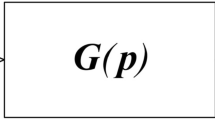Abstract
The approach most widely used for the modelling of flexible bodies in multibody systems has been called the floating frame of reference formulation. In this methodology the flexible body motion is subdivided into a reference motion and deformation. The displacement field due to deformation is approximated by the Ritz method as a product of known shape functions and unknown coordinates depending on time only. The shape functions may be obtained using finite-element-models of flexible bodies in multibody systems, resulting in a detailed system representation and a high number of system equations. The number of system equations of such a nodal approach can be reduced considerably using a modal representation of deformation. This modal approach, however, leads to the fundamental problem of selecting the shape functions.
The floating frame of reference formulation is reviewed here using a generic flexible body model, from which the various body models used in multibody simulations may be derived by formulation of specific constraint equations. Special attention is given in this investigation to the following subjects:
• The separation of flexible body motion into a reference motion and deformation requires the definition of a body reference frame, which in turn affects the choice of shape functions. Some alternatives will be outlined together with their advantages and disadvantages.
• Assuming the body deformation to be small, the system equations can be linearized. This may require considering geometric stiffening terms. The problem of how to compute these terms has been solved in literature on the instability of structures under critical loads. For finite element models the geometric stiffening terms are obtained from the tangential stiffness matrix.
• The generality of the flexible body model allows the definition of an object oriented data base to describe the system bodies. Such a data base includes a general interface between multibody- and finite-element-codes.
• By combining eigenfunctions and static deformation modes to represent body deformation one obtains a set of so-called quasi-comparison functions. When selected properly these functions can be shown to improve the representation of stresses significantly.
Similar content being viewed by others
References
Eich-Soellner, E. and Führer C., Numerical Methods in Multibody Dynamics, Teubner, Stuttgart, 1998.
Shabana, A. A., ‘Flexible multibody dynamics: review of past and recent developments’, Multibody System Dynamics 1, 1997, 189–222.
Koppens, W. P., Sauren, A. A., Veldpaus, F. E., and van Campen, D. H., ‘The dynamics of a deformable body experiencing large displacements’, Journal of Applied Mechanics 55, 1988, 676–680.
Shabana, A. A., ‘Resonance conditions and deformable body coordinate systems’, Journal of Sound and Vibration 192(1), 1996, 389–398.
Schwertassek, R. and Wallrapp, O., Dynamik flexibler Mehrkörpersysteme, Vieweg, Braunschweig, 1999.
Kane, T. R., Ryan, R. R., and Banerjee, A. K., ‘Dynamics of a cantilever beam attached to a moving base’, Journal of Guidance, Control, and Dynamics 10(2), 1987, 139–151.
Schwertassek, R., ‘Flexible bodies in multibody systems’, in Computational Methods in Mechanical Systems, J. Angeles and E. Zakhariev (eds.), Springer-Verlag, Berlin, 1997, pp. 329–363.
Prandtl, L., ‘Kipp-Erscheinungen - Ein Fall von instabilem elastischem Gleichgewicht’, Dissertation, Ludwigs-Maximilian Universität zu München, Sektion II der philosophischen Fakultät, 1899.
Weidenhammer, F., ‘Gekoppelte Biegeschwingungen von Laufschaufeln im Fliehkraftfeld’, Ingenieur-Archiv 39, 1970, 281–292.
Truckenbrodt, A., Bewegungsverhalten und Regelung hybrider Mehrkörpersysteme mit Anwendung auf Industrieroboter, Fortschritt-Bericht VDI, Reihe 8: Meß-, Steuerungs-und Regelungstechnik, Nr. 33, VDI-Verlag, Düsseldorf, 1980.
Bremer, H. and Pfeiffer, F., Elastische Mehrkörpersysteme, Teubner, Stuttgart, 1992.
Ritz, W., ‘Theorie der Transversalschwingungen einer quadratischen Platte mit freien Rändern’, Annalen der Physik IV, 1909, 737–786.
Courant, R. and Hilbert, D., Methoden der mathematischen Physik, Springer-Verlag, Berlin, 1968.
Veubeke, B. F., ‘The dynamics of flexible bodies’, International Journal of Engineering Sciences 14, 1976, 895–913.
Gylden, H., ‘Recherches sur la rotation de la Terre’, Actes de la Société Royale des Sciences d'Upsal, April 5, 1871, 1–21.
Tisserand, F., Traite de Mechanique Celeste, Gauthier-Villars, Paris, 1891.
Canavin, J. R. and Likins, P.W., ‘Floating reference frames for flexible spacecraft’, in AIAA 15th Aerospace Sciences Meeting, Los Angeles, CA, 1977, Paper No. 77–66.
Agrawal, O. P. and Shabana, A. A., ‘Application of deformable-body mean axis to flexible multibody system dynamics’, Computer Methods in Applied Mechanics and Engineering 56, 1986, 217–245.
Meirovitch, L. and Kwak, M. K., ‘Convergence of the classical Rayleigh-Ritz method and the finite element method’, AIAA Journal 28(8), 1990, 1509–1516.
Tychonoff, A. N. and Samarski, A. A., Differentialgleichungen der mathematischen Physik, Deutscher Verlag der Wissenschaften, Berlin, 1959.
Meirovitch, L. and Kwak, M. K., ‘On the modeling of flexible multi-body systems by the Rayleigh-Ritz method’, Paper presented at the AIAA Dynamics Specialists Conference, Long Beach, CA, April 1990.
Meirovitch, L. and Hagedorn, P., ‘A new approach to the modelling of distributed non-self-adjoined systems’, Journal of Sound and Vibration 178(2), 1994, 227–241.
Hagedorn, P., ‘Quasi-comparison functions in the dynamics of elastic multibody systems’, in Dynamics and Control of Large Structures, Proceedings of the 8th VPI &SU Symposium, Blacksburg, VA, May 6–8, L. Meirovitch (ed.), 1991, pp. 97–108.
Hagedorn, P., ‘The Rayleigh-Ritz method with quasi-comparison functions in nonself-adjoint problems’, Journal of Vibration and Acoustics 115, 1993, 280–284.
Schwertassek, R. and Rulka, W., ‘Aspects of efficient and reliable multibody system simulation’, in Real-Time Integration Methods for Mechanical System Simulation, E. J. Haug and R. C. Deyo (eds.), Springer-Verlag, Berlin, 1991, pp. 55–96.
Roberson, R. E. and Schwertassek, R., Dynamics of Multibody Systems, Springer-Verlag, Berlin, 1988.
Volterra, E., ‘The equations of motion for curved elastic bars deduced by the use of the 'method of internal constraints’, Ingenieur-Archiv XXIII, 1955, 402–409.
Volterra, E., ‘The equations of motion for curved and twisted elastic bars deduced by the use of the 'method of internal constraints’, Ingenieur-Archiv XXIV, 1956, 392–400.
Fung, Y. C., Foundations of Solid Mechanics, Prentice-Hall, Englewood Cliffs, NJ, 1965.
Washizu, K., Variational Methods in Elasticity and Plasticity, 3rd edition, Pergamon Press, Oxford, 1982.
Pascal, M., ‘Dynamics analysis of a system of hinge-connected flexible bodies’, Celestial Mechanics 41, 1988, 253–274.
Sachau, D., ‘Berücksichtigung von Körperverformung und Fügestellen in der Mehrkörpersimulation mit Anwendung auf aktive Raumfahrtstrukturen’, Dissertation, Universität Stuttgart, 1996.
Padilla, C. E. and von Flotow, A. H., ‘Nonlinear strain-displacement relations and flexible multibody dynamics’, AIAA Journal of Guidance, Control and Dynamics 15, 1992, 128–136.
Banerjee, A. K. and Dickens, J.M., ‘Dynamics of an arbitrary flexible body in large rotation and translation’, AIAA Journal of Guidance, Control and Dynamics 13(2), 1990, 221–227.
Banerjee, A. K., ‘Block-diagonal equations for multibody elastodynamics with geometric stiffness and constraints’, AIAA Journal of Guidance, Control and Dynamics 16(6), 1993, 1092–1100.
Zienkiewicz, O. C. and Taylor, R. L., The Finite Element Method: Solid and Fluid Mechanics Dynamics and Non-linearity, Vol. 2, McGraw-Hill, London, 1991.
Otter, M., Hocke, M., and Leister, G., ‘An object oriented data model for multibody systems’, in Advanced Multibody System Dynamics - Simulation and Software Tools, W. Schiehlen (ed.), Kluwer, Dordrecht, 1993, pp. 19–48.
Wallrapp, O., ‘Standard input data of flexible members for multibody system codes’, in Advanced Multibody System Dynamics - Simulation and Software Tools, W. Schiehlen (ed.), Kluwer, Dordrecht, 1993, pp. 445–450.
Shames, I. H. and Dym, C. L., Energy and Finite Element Methods in Structural Mechanics, Hemisphere, New York, 1985.
Swanson-Analysis-System, ANSYS User's Manual for Rev. 5.0, Vol. I to IV, Swanson Analysis System, Houston, PA, 1992.
Wallrapp, O., ‘Beam - A pre-processor for mode shape analysis of straight beam structures and generation of the SID file for MBS codes, User's manual’, Report Deutsche Forschungsanstalt für Luft-und Raumfahrt (DLR), Institut für Robotik und Systemdynamik, Oberpfaffenhofen, 1994.
Wallrapp, O., Eichberger, A., and Gerl, J., ‘FEMBS - An interface between FEM codes and MBS codes, User manual for ANSYS, NASTRAN, and ABAQUS’, Report INTEC GmbH, Wessling, 1997.
Mangler, D., ‘Die Berechnung geometrisch nichtlinearer Probleme der Dynamik unter Nutzung linearer FEM-Programme’, Dissertation, Otto-von-Guericke-Universität, Magdeburg, 1994.
Author information
Authors and Affiliations
Rights and permissions
About this article
Cite this article
Schwertassek, R., Wallrapp, O. & Shabana, A.A. Flexible Multibody Simulation and Choice of Shape Functions. Nonlinear Dynamics 20, 361–380 (1999). https://doi.org/10.1023/A:1008314826838
Issue Date:
DOI: https://doi.org/10.1023/A:1008314826838




